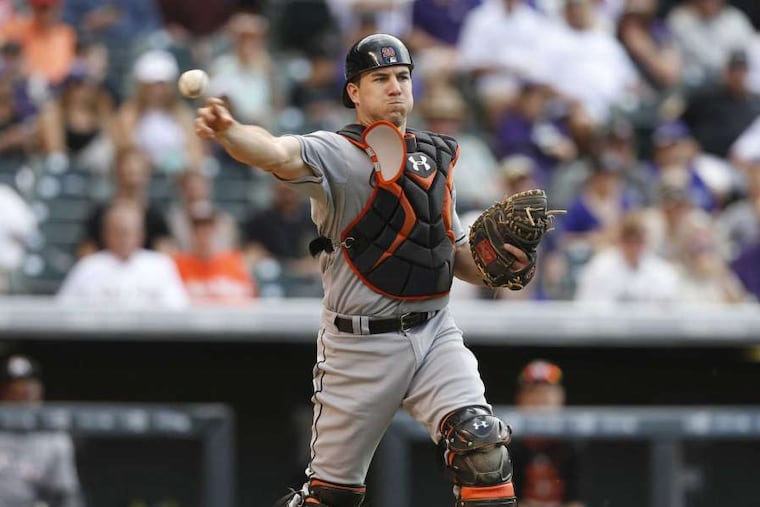Phillies star J.T. Realmuto turned into a catcher thanks to two visionary scouts and a little luck
Two Marlins scouts recognized Realmuto's potential as a catcher almost before he ever started playing the position.

Tim Cossins never asked what made the two Miami Marlins scouts believe that a kid who had caught fewer than a handful of games in high school could someday be a top major-league catcher.
Then again, J.T. Realmuto never gave Cossins reason for skepticism.
If Realmuto isn’t a natural behind the plate, well, he’s darn close. Unlike Johnny Bench, the most accomplished catcher from Oklahoma, Realmuto wasn’t born with a chest protector and shin guards. He played primarily shortstop at Carl Albert High School in Midwest City, Okla., and likely would have stayed in the infield if he’d kept his commitment to Oklahoma State.
You wouldn’t have guessed that, Cossins said by phone, if you had watched Realmuto catch 76 games at low-A Greensboro in 2011, his first full season after amateur scout Steve Taylor recommended the Marlins spend a third-round pick to draft him as a catcher. And you certainly wouldn’t know it now that Realmuto is an All-Star and the biggest addition (so far) in a potentially transformational offseason for the Phillies.
“The first thing I thought about with J.T. was, ‘This is what [scouts] are traveling around the country looking for,’” said Cossins, then the Marlins’ minor-league catching coordinator. “The arm strength was real, the left [glove] hand was real, and then the makeup was immediately the strongest tool. It was an instructor’s dream to have somebody that tooled-up with being that raw.”
As a finished product, Realmuto is the best all-around catcher in baseball. Since 2016, the 27-year-old leads all catchers in runs (202), hits (434), doubles (92), and Fangraphs’ Wins Above Replacement (12.3). His quiet leadership prompted Marlins manager Don Mattingly recently to compare him, quite ironically, to Derek Jeter, who is orchestrating the full-scale rebuild that prompted Realmuto to request a trade.
The Phillies checked in on Realmuto’s availability in November, waited for the asking price to dip, and still gave up prized pitching prospect Sixto Sanchez in last week’s blockbuster. And the consensus across baseball is that Realmuto is well worth it.
“I’ll say this,” one American League team official said last week. “The Phillies just got a lot better.”
But for as well as Realmuto turned out, it required considerable foresight — and just as much serendipity — to render the triumphant scouting projection that he would succeed as a catcher.
In the spring of 2010, Realmuto attracted scouts to Carl Albert High because of his abilities as a shortstop. But on the day that Taylor and Marlins scouting director Stan Meek showed up, he happened to be filling in behind the plate because the team’s regular catcher was pitching.
It was believed to be the only game that Realmuto caught all spring.
Taylor, now a scout for the Detroit Tigers, turned down an interview request because he prefers not to discuss other teams’ players publicly. Likewise, Meek still works for the Marlins and declined comment. But the story goes that they chatted with Realmuto after the game and asked if he’d be willing to make the transition to catcher if the Marlins drafted him.
“A lot of times, guys don’t want to go back there to that position,” former Marlins catching coach Rob Leary said by phone. “It was something that he wanted to do.”
Leary remembers hearing that the Marlins doubted Realmuto would stay at shortstop in pro ball but that Taylor and Meek were nevertheless struck by his athleticism and believed it would play up more behind the plate than at another infield position. Cossins recalled that the Marlins’ scouting efforts at the time were focused on turning up catching talent wherever possible.
Realmuto’s skills still needed refinement. In particular, there was a “crudeness” to his blocking technique, according to Cossins, who began working with Realmuto in rookie ball.
“Having the ability to start with him on a very real Day 1 [as a catcher] and build on it, that was fascinating,” Cossins said. “To watch him improve as quickly as he did and take to it like he did was outstanding.”
But Realmuto never needed help running a game or directing a pitcher. Perhaps it came from quarterbacking his high school football team. Maybe he just had a higher baseball IQ than most of his peers. Regardless, leadership seemed to be an innate quality for Realmuto.
Leary noticed it in spring training of 2013, when the Marlins invited Realmuto to big-league camp. Never mind that he had not yet played above the Class A level or that he’d been a full-time catcher for only two years. He took charge with pitchers and sought feedback from veteran catcher Jeff Mathis, who is so solid defensively that he has stuck around the majors for 14 seasons despite being a .198 career hitter.
“People talk about ‘the look,’ ” Cossins said. “J.T.’s got this look that, he doesn’t have to do much to get people’s attention. It takes very little time around J.T. to respect him, and it takes very little for him to affect other people. I’ve had a handful of guys like that in the past. They don’t come around that often.”
Said Leary: “He had an air about him. He had confidence. He knew he had a lot of work to do, but through conversation and just watching him and working with him on a daily basis, you knew this kid was going to work and will himself to become a front-line catcher.”
And now it’s the Phillies’ turn to reap the benefits. It’s never too late to send a note of thanks to Taylor and Meek for believing Realmuto could catch almost before he ever tried.